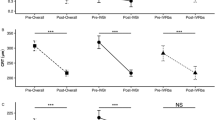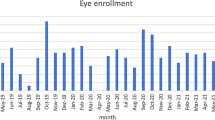Abstract
Purpose
To evaluate the effects of epiretinal membrane (ERM) formation on the anatomic and functional results of subjects with diabetic macular edema (DME) who are receiving intravitreal aflibercept injections (IAIs).
Materials and methods
This retrospective comparative study includes 29 eyes with DME (Group 1) and 43 eyes with DME and ERM (Group 2). After three consecutive monthly 2.0 mg IAIs, subjects received monthly follow-ups and retreatment was performed if needed. Corrected visual acuity (CVA), central macular thickness (CMT), and central macular volume (CMV) parameters were recorded tri-monthly, and the 36-month follow-up was designated the primary endpoint of the study.
Results
There was no significant difference between groups when comparing the mean ages and male-to-female ratios (p > 0.05, for both). At the baseline, the mean CVA value was significantly worse (p = 0.002), and the mean CMT was significantly lower (p = 0.016) in Group 1, while there was no significant difference in terms of the mean CMV (p = 0.625). The mean number of IAIs was similar at the first (p < 0.102), second (p = 0.363), and third year (p = 0.850) follow-ups. The mean CVA was significantly worse, and CMT was significantly lower in Group 1 at most of the visits in the first half of the follow-up period (p < 0.05, for all), while there was no significant difference in the second half of the follow-up period. There was no significant difference between groups in terms of CMV at any visit (p > 0.05, for all).
Conclusion
Despite a similar number of IAIs needed, worse baseline clinical parameters are associated with poorer early- or mid-term outcomes. At the long-term follow-up, CVA and CMT became similar in DME independent of ERM.

Similar content being viewed by others
References
Klein R, Klein BE, Moss SE, Cruickshanks KJ (1995) The Wisconsin Epidemiologic Study of Diabetic Retinopathy. XV. The long-term incidence of macular edema. Ophthalmology 102(1):7–16
Behl T, Kotwani A (2015) Exploring the various aspects of the pathological role of vascular endothelial growth factor (VEGF) in diabetic retinopathy. Pharmacol Res 99:137–148
Antonetti DA, Barber AJ, Khin S, Lieth E, Tarbell JM, Gardner TW et al (1998) Vascular permeability in experimental diabetes is associated with reduced endothelial occludin content: vascular endothelial growth factor decreases occludin in retinal endothelial cells. Penn State Retina Research Group. Diabetes 47:1953–1959
Kaya M, Kaya D, Idiman E, Kocak N, Ozturk T, Ayhan Z et al (2019) A novel biomarker in diabetic macular edema with serous retinal detachment: serum chitinase-3-like protein 1. Ophthalmologica 241:90–97
Chang CK, Cheng CK, Bai CH, Peng CH, Hu CC (2012) Development of vitreomacular interface abnormality in patients with diabetic macular edema. Taiwan J Ophthalmol 2(3):93–98
Knyazer B, Schachter O, Plakht Y et al (2016) Epiretinal membrane in diabetes mellitus patients screened by non-mydriatic fundus camera. Can J Ophthalmol 51:41–46
Yamamoto T, Akabane N, Takeuchi S (2001) Vitrectomy for diabetic macular edema: the role of posterior vitreus detachment and epimacular membrane. Am J Ophthalmol 132(3):369–377
Yoon D, Rusu I, Barbazetto I (2014) Reduced effect of anti-vascular endothelial growth factor agents on diabetics with vitreomacular interface abnormalities. Int Ophthalmol 34(4):817–823
Seko Y, Seko Y, Fujikura H, Pang J, Tokoro T, Shimokawa H (1999) Induction of vascular endothelial growth factor after application of mechanical stress to retinal pigment epithelium of the rat in vitro. Invest Ophthalmol Vis Sci 40(13):3287–3291
Wu PC, Lai CH, Chen CL, Kuo CN (2012) Optical coherence tomographic patterns in diabetic macula edema can predict the effects of intravitreal bevacizumab injection as primary treatment. J Ocul Pharmacol Ther 28:59–64
Ercalik NY, Imamoglu S, Kumral ET et al (2016) Influence of the epiretinal membrane on ranibizumab therapy outcomes in patients with diabetic macular edema. Arq Bras Oftalmol 79:373–375
Wong Y, Steel DHW, Habib MS et al (2017) Vitreoretinal interface abnormalities in patients treated with ranibizumab for diabetic macular oedema. Graefes Arch Clin Exp Ophthalmol 255:733–742
Papadopoulos N, Martin J, Ruan Q, Rafique A, Rosconi MP, Shi E et al (2012) Binding and neutralization of vascular endothelial growth factor (VEGF) and related ligands by VEGF Trap, ranibizumab and bevacizumab. Angiogenesis 15(2):171–185
Bressler SB, Qin H, Beck RW et al (2012) Diabetic retinopathy clinical research network. Factors associated with changes in visual acuity and central subfield thickness at 1 year after treatment for diabetic macular edema with ranibizumab. Arch Ophthalmol 130(9):1153–1161
Cetin EN, Demirtaş Ö, Özbakış NC, Pekel G (2018) Quantitative assessment of macular contraction and vitreoretinal interface alterations in diabetic macular edema treated with intravitreal anti-VEGF injections. Graefes Arch Clin Exp Ophthalmol 256(10):1801–1806
Rouvas A, Petrou P, Ladas I, Neamonitou G, Vergados I (2008) Spontaneous resolution of vitreomacular traction following ranibizumab (Lucentis) injection. Eur J Ophthalmol 18(2):301–303
Maryam AK, Tafgeh M, Mahmoud M, Pasha A, Ahad S, Khalil GF (2018) Short term effect of intravitreal bevacizumab for diabetic macular edema associated with epiretinal membrane. Rom J Ophthalmol 62(3):212–216
Cho HJ, Kim JM, Kim HS, Lee DW, Kim CG, Kim JW (2017) Effect of epiretinal membranes on antivascular endothelial growth factor treatment for neovascular age-related macular degeneration. J Ocul Pharmacol Ther 33(6):452–458
Curry BA, Sanfilippo PG, Chan S, Hewitt AW, Verma N (2020) Clinical outcomes of a treat and extend regimen with intravitreal aflibercept injections in patients with diabetic macular edema: experience in clinical practice. Ophthalmol Ther 9(1):87–101
Plaza-Ramos P, Borque E, García-Layana A (2019) Evaluation of ranibizumab and aflibercept for the treatment of diabetic macular edema in daily clinical practice. PLoS ONE 14(10):e0223793
Author information
Authors and Affiliations
Contributions
The authors alone are responsible for the content and writing of this paper. The authors have indicated they have no financial relationships with any company and no external funding. Involved in design and conduct of this study (AKA, CI, MC); involved in collection, management, analysis, and interpretation of the data (CI, AKA); involved in preparation, review, or approval of the manuscript (AKA, CI, MC). All persons named in the Acknowledgments section have provided written permission to be named.
Corresponding author
Ethics declarations
Conflict of interest
All authors have completed and submitted the ICMJE Form for Disclosure of Potential Conflicts of Interest. The authors report no conflicts of interest.
Ethical approval
This article does not contain any studies with human participants or animals performed by any of the authors.
Informed consent
Informed consent was obtained from all individual participants included in the study.
Additional information
Publisher's Note
Springer Nature remains neutral with regard to jurisdictional claims in published maps and institutional affiliations.
Rights and permissions
About this article
Cite this article
Kocak Altintas, A.G., Ilhan, C. & Cankurtaran, M. The effects of epiretinal membranes on the treatment outcomes of intravitreal aflibercept injection in diabetic macular edema: a real-life study. Int Ophthalmol 40, 2635–2641 (2020). https://doi.org/10.1007/s10792-020-01444-y
Received:
Accepted:
Published:
Issue Date:
DOI: https://doi.org/10.1007/s10792-020-01444-y




